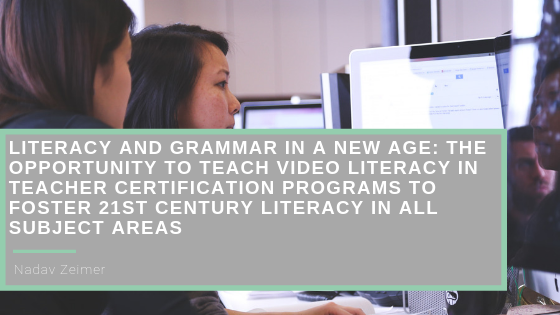In the past few decades, our culture shifted from print-based to screen-based information consumption. Focusing on videos, in particular, US adults spend almost six hours a day watching videos, either through their televisions or on their phones, tablets, and computers. Millennials, in particular, are 92% of the video viewing audience for digital platforms. Children are right behind adults in those numbers. Even with most Americans spending a quarter of their lives on video today, those numbers are only expected to increase.
What is Screen Literacy?
The changing culture affords us a unique opportunity to revamp the education system and use these shifts to our advantage. Screen literacy must become a focus for our teachers. Screen literacy includes audio, still image, and all the various ways that information is presented to us on a screen. In fact screen literacy includes understanding how we are manipulated through our screens, how a user interface works, and how the quality of our attention is our primary value proposition in a digital economy. Companies are all fighting over our attention. Let’s simplify this discussion by focusing on video literacy as a place to start.
First, we must understand what video literacy entails. Video literacy is a type of digital literacy, which is not only the ability to use digital technology, but also the ability to read and interpret media, to apply what we learn from digital environments and to reproduce data and images. So, it follows that video literacy is not only the ability to watch videos but to learn from them, to analyze the visual vocabulary effectively and create them.
If we recognize that video literacy for educators is a priority, we should be teaching it as part of teaching certification programs. Here are several of the benefits of teaching video literacy to our educators:
Benefits for Students
If teachers are video literate they will be able to incorporate more videos in the classroom. Most teachers believe the educational videos are beneficial for learning. Videos are engaging, allowing students to hear and see concepts rather than simply reading about them. Students are more likely to retain information if they are engaged. Videos also help students to learn difficult subjects more easily and promote digital literacy, which becomes a more important skill by the day. But just showing videos the way teachers have been doing, rolling that monster TV/VCR combo cart into the classroom, or hitting play on a video on the SMART board, can easily have the opposite effect – it would be much better for students to watch a video on their own than to watch en mass in this way. Teachers have to be taught how to effectively engage video content in a classroom just the way they learn how to engage text on a page with close reading activities. Video literacy is a skill that must be learned.
Benefits for Teachers and Schools
Videos are convenient in many ways. A student could be at home sick and still watch the video that their classmates watched in school that day. Teachers could also provide access to videos online for students to reference later. To produce a quality video involves writing scripts, researching and engaging in a multitude of complex academic habits to prepare for the moment when we pick up a camera to start executing a well planned shot or sequence. Video editing also builds some important executive function as we ask ourselves what is worth keeping and what can be left out of the final cut.
Institutions can also use videos in online courses, to record campus events or to help train new employees. They are also incredibly useful for marketing and school-wide communication.
If we want our students, teachers and institutions to experience these benefits, It’s imperative that we make the changes necessary to train our educators in video literacy.
Taking It a Step Further
Our future educators are not the only ones who should be focusing on video literacy. Video literacy is a skill that should be passed on to students as well.
Video literacy is not just important for the future cameramen of the world. As Michael Rosenblum points out, when the printing press was invented, most of Europe was illiterate. Yet today, reading and writing are the foundations of our education system. So as our culture continues to shift to screening rather than reading, it’s important that everyone, teachers and students alike, become video literate to express their ideas and analyze the ideas they are consuming through their screens.
Of course, video literacy cannot be taught to students by video illiterate educators, so educators need to be the immediate focus. It starts by including video literacy classes as part of the certification process. We owe it to our educators and students to keep our training programs on pace with our rapidly changing world.
